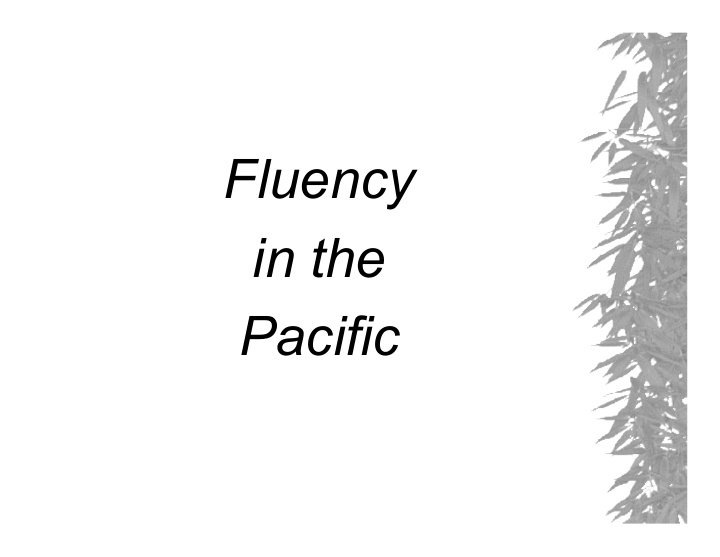



Fluency in the Pacific
The Pacific Region 9 island communities across the Pacific including Micronesia English is the second language Language of Instruction for Grades 1-3 is the vernacular Rich oral tradition Little to no printed material in local languages found in classrooms
“Evidence indicates that repeated oral reading with guidance and feedback helps to improve the reading ability of typically developing readers until at least 5 th grade. It also helps struggling readers at higher grade levels.” (Osborn, Lehr, Hiebert, 2003, as stated in National Reading Panel, 2000)
Repeated Oral Reading through: • Poetry • Student Reading Own Writing • Readers Theater
Why Poetry? Motivational Natural way to practice reading with fluency – phrasing and rhyming Lends itself to rereading A relatively short reading selection that can be translated into the vernacular within a reasonable time Relatively easy to obtain Builds sight words while it increases the knowledge of content words
What are the steps? Select relevant poems Translate poem to vernacular Before Reading Introduce –Vocabulary/concepts Guide background connections
During Reading First read the poem to the students “ By reading effortlessly and with expression, you are modeling for your students how a fluent reader sounds during reading.” (Armbruster, Lehr, Osborn, 2001) Second Reading: Students share in the reading
Third Reading: Add expression to show the meaning of the words Additional Readings: Add dramatization and creative division of parts Consider partner and small group work “Various forms of partner reading have been found to produce significant gains in fluency.” (Osborn, Lehr, Hiebert, 2003, as stated in Eldregde, 1990, Koskinen & Blum, 1986) Share oral interpretation of the poem “Students who read and reread passages orally as they receive guidance and/or feedback become better readers.” (Armbruster, Lehr, Osborn, 2001)
Fluency is “the ability to read a text quickly, accurately, and with proper expression”. (Osborn, Lehr, Hiebert, 2003, as stated in National Reading Panel, 2000 ) Repeated readings of poem allow the students to see what it sounds like and feels like to read fluently From repeated exposure to text, additional sight words are learned. “The importance to reading success of helping students to develop a large sight word vocabulary is clear.” (Osborn, Lehr, Hiebert, 2003) As they learn more sight words, they read more fluently and they can devote more attention to comprehension.
After Reading Discuss ideas and concepts Lead a shared writing activity – Teacher & students write a poem or a story motivated by the poem Shared writing becomes additional reading material for students Students do independent writing Student writing is made into a class book
Read Own Writing to Build Fluency Look for relevant articles in the newspaper or magazines Model fluent reading by reading the article to students Using a semantic map, record students’ words for such questions as: – who, what, where, when, and why Students summarize the article using semantic map of key words Students partner read summaries Volunteers read their summary to class
Students are able to read their own stories fluently because they have heard the words, spoken them, and used them in their own writing. See the attached article, Teaching with Ingenuity: Using the Newspaper to Teach Reading And Writing, Hanson, 2004. Student stories become reading material for the class.
Repeated Reading through Readers Theater What is Readers Theater? – A story, play, poem, or other reading material is read aloud for an audience – The meaning of the selection is shown through the voice of the reader Why use Readers Theater? – “Some research has shown that, as a result of the repeated readings necessary to prepare for Readers Theater, students make significant gains in fluency.” (Osborn, Lehr, Hiebert, 2003, as stated in Rasinski, 1999)
Readers Theater: Rational Local stories and legends can be turned into scripts Fluency is developed as the students read and reread text to perform for an audience – Students are highly motivated to reread – Students decide how to best show the meaning in their voice
Students self-evaluate, peer evaluate, and receive a teacher evaluation using the Readers Theater Evaluation that includes criteria like: – I read the words like the character might have sounded – I used expression in my voice such as excitement, wonder, love – See Readers Theater Evaluation in the attachments
Resources for Readers Theater: Martinez, M., Roser, N.L., Strecker, S. (December 1998/January 1999) “I never thought I could be a star”: A Readers Theater ticket to fluency. The Reading Teacher , 52 (4), 379-387. Griffith, L.W., Rasinski, T.V. (2004, October) A focus on fluency: How one teacher incorporated fluency with her reading curriculum. The Reading Teacher , 58 (2), 126-137. Opitz, M., Rasinski, T. (1998) Good-bye round robin: Twenty five effective oral reading strategies . (Portsmouth, NH: Heinemann.
“… all effective repeated reading procedures have two features in common: 1. They provide students with many opportunities to practice reading 2. They provide students with guidance in how fluent readers read and with feedback to help them become aware of and correct their mistakes.” (Osborn, Lehr, Hiebert, p. 14) Shared poetry reading, student reading of own writing, and Readers Theater has these features.
Presenters Susan Hanson, Program Specialist Pacific Resources for Education and Learning (PREL) 900 Fort Street Mall, Suite 1300 Honolulu, Hawai’i 96813 Email: hansons@prel.org PH: 808-441-1300 Janice Jenner, Consultant 343 Hobron Lane #1103 Honolulu, Hawai`i 96815 Email: jennerj003@hawaii.rr.com PH: 808-223-8626
Recommend
More recommend